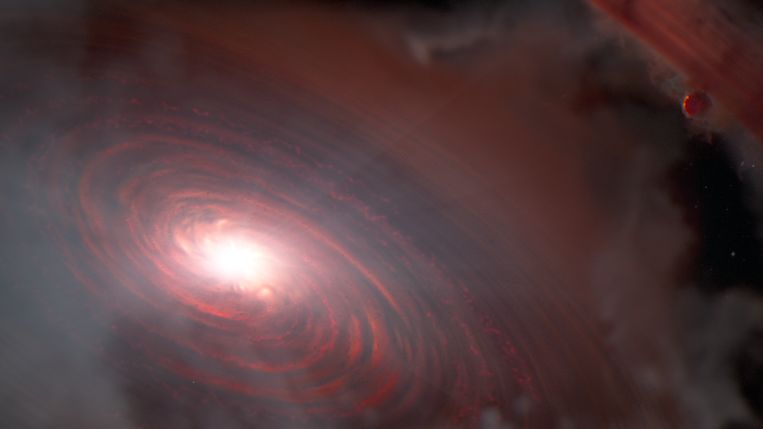Where did the water come from on Earth is one of the open mysteries in science. Did they already exist when our planet formed, over 4.5 billion years ago? Or was it delivered later, through the collisions of comets and asteroids? The James Webb Space Telescope has now found the beginning of an answer. Not by studying Earth’s past, but by looking at another planetary system under construction.
The young star PDS 70, which is 370 light-years away and about 5.4 million years old, is surrounded by a disk of gas and dust particles in which two newborn giant planets have already been discovered. Together, they wiped out a wide area in the disc. Everything indicates that smaller Earth-like planets are clustered together in the inner part of the disk.
Using the James Webb Telescope’s Merry instrument, water vapor has now been detected in that inner region, with a temperature of more than 300 degrees. Thus these water molecules can become part of the planets that form there. The discovery was published this week in the journal nature.
“An unexpected result,” says Gijs Mulders of the Chilean Adolfo Ibañéz University. He is searching for exoplanets (planets around other stars) and is not involved in the new discovery. According to Mulders, it is generally assumed that the interiors of planetary systems due to have “dried up”, in part due to the heat of the central star. The water molecules then split into separate hydrogen and oxygen atoms.
The search for extraterrestrial life
It seems unlikely that the water in the inner portions of the disk around PDS 70 originates from the outermost portions. Although there are dust particles covered in a thin layer of ice, such frozen dust can never “cross” the wide empty region in which the two newborn giant planets orbit. So the water vapor is likely to be of “local” origin. How the water molecules can remain intact at such a small distance from the star is not clear.
“This is an exciting discovery,” says Yamila Miguel, an exoplanet researcher from the Leiden Observatory in the Netherlands, who was also not involved in the research. “Water is essential to life as we know it, so it is remarkable that it appears to be present in regions where Earth-like planets are forming, although of course this is no guarantee that life will develop on those planets in the future.”
Mulders also notes the importance of the search for extraterrestrial life. “This means that water may be present on more planets than previously thought,” he says.
The hope is that James Webb will also find water vapor in many other planetary systems in the future. In addition, new, detailed observations of PDS 70 have been scheduled using the Nircam space telescope’s camera.

“Total coffee specialist. Hardcore reader. Incurable music scholar. Web guru. Freelance troublemaker. Problem solver. Travel trailblazer.”







More Stories
GALA lacks a chapter on e-health
Weird beer can taste really good.
Planets contain much more water than previously thought